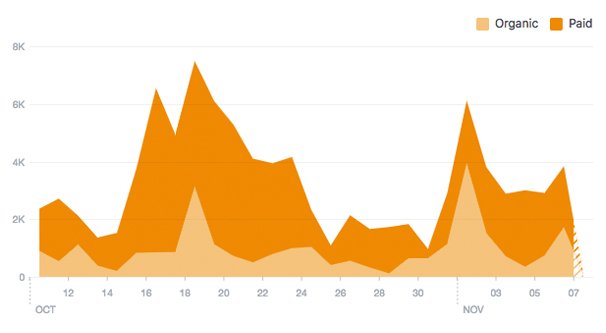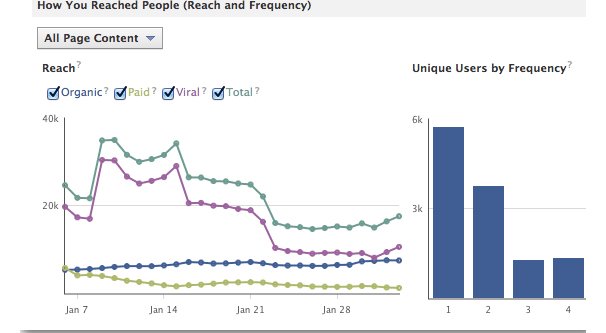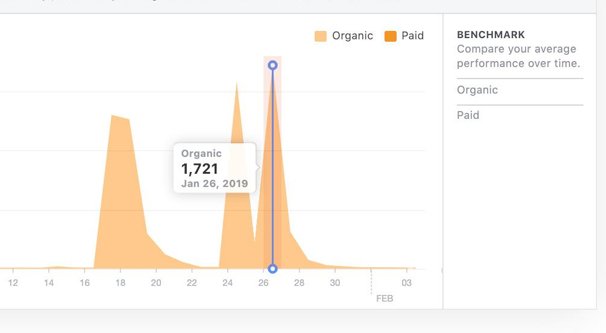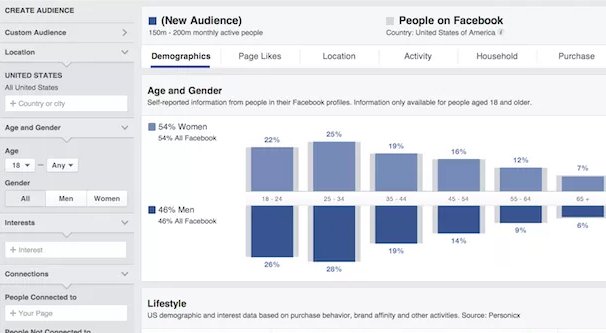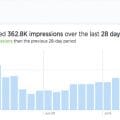Facebook reach metrics have changed a lot over the last few years. Or, rather, they haven’t changed, but the division of what Facebook records and shows you has changed.
In the past, Facebook would show you three kinds of reach: organic, paid, and viral. Today, they only show you organic reach and paid reach. Viral reach still exists; it’s simply a sub-category of organic reach now.
Confused? I sure was the first time I had to go through all of this. So let’s start at the beginning: what even is reach in the first place?
The Definition of Reach
Reach, as a specific term for a specific kind of data, is a metric Facebook monitors and shows you in your Insights for a Page.
To view Reach, log into Facebook and visit your Page. Look above your cover photo for the white bar and find Insights. Click on that and you will see a grid summary of the past week. One of the boxes is Post Reach, another is Story Reach. Below that grid you can see recent posts with a bar that shows Reach. Additionally, to the left side there’s a Reach entry in the sidebar, which takes you to a series of charts showing you reach over time.
So what is Reach, specifically? The piece of data most equivalent that you may have encountered in other analytics suites is “unique impressions.” Basically, Reach is the number of people who have seen a piece of content you have published.
If you publish a post and one person sees it once, it’s 1 Reach. If that person sees the post again tomorrow, it’s still 1 Reach, because it’s just one person. If 10 people see the post, your post has 10 Reach. It literally reaches 10 people.
Now, there are a lot of tricky little bits of information relating to Reach that can skew these numbers and this understanding. Let’s go through them.
First up, Reach is the total number of people who have had any of your posts from your Page enter their screen. The applicable phrase here is “enter their screen.” If they’re scrolling through their Facebook feed really quickly and barely even get a glance at your post, that’s still +1 Reach. If they’re scrolling down and only load the top quarter of your post, such that they only see your Page name and some of the image, none of the copy, and none of the interaction, it’s still +1 Reach.
When Facebook Insights shows you Reach, they show you Paid Reach and Organic Reach. What’s the difference between those two?
- Paid Reach is the number of people who have a post on their screen when you paid to put it there. Any time you boost a post or run a page post format ad, the unique impressions that ad gets are Paid Reach.
- Organic Reach is the number of people who have a post on their screen when you have not paid to put it there. Followers seeing your posts in their feeds give you additional Reach.
Additionally, Organic Reach is divided into two kinds of Reach: Viral and Nonviral. Nonviral Reach is Reach where the user is following you directly, browsing your Page, or otherwise seeing your posts because of their own actions. Viral reach is any time someone sees one of your posts because of the actions of someone else. For example, if you and I were friends on Facebook and I liked a post from a Page, and you saw the post because I liked it, I would be +1 nonviral Reach and you would be +1 viral reach.
If you think about it in terms of degrees of separation, nonviral Reach is first degree, and viral reach is second degree, one further step removed.
There are also oddities in the way Reach is counted. Here are a few scenarios that illustrate them.
First, if someone sees your post because of Viral Reach, and then clicks through to see posts on your Page and sees that post again, they will not be counted as nonviral Reach. They give you +1 Viral Organic Reach and that’s it. At least, in an isolated situation where you only have that one post, they do. If you have multiple posts, they’ll be +1 Reach for each of them.
If someone sees your ad, they give you +1 Paid Reach. If they then decide to follow your account and see the post you boosted organically, they will give you +1 Organic Reach as well. This happens a lot when you’re running advertising targeting the people who already follow you.
However, Reach does not overlap. In your general Facebook Insights, you will see Post Reach, which is the total count of combined Paid and Organic Reach numbers. Except the numbers don’t always add up. You might see 10 Paid Reach and 10 Organic Reach, but only 18 Post Reach. What gives?
If someone sees your post organically, and then sees a paid version of your post, they will give you +1 Paid Reach, +1 Organic Reach, and +1 Total Reach.
It makes sense, right? They saw your post as an ad, so plus one paid Reach. They saw your post organically, so plus one Organic Reach. But they’re only one person, so only one unique Post Reach. To put it in words directly from Facebook, “The sum of organic and paid reach won’t always equal post reach.”
Additionally, just to throw one final wrench into the works, when you’re looking at Reach numbers in Insights, every one of them has a disclaimer that “This number is an estimate and may not be precise.” The larger your audience, the more they end up needing to fudge the data a little, and the less accurate the number becomes.
What’s the Difference Between Organic and Viral Reach?
Now to bring things back to the original title of this post, what’s the difference specifically between organic Reach and viral Reach?
The answer is that viral Reach is a subset of organic Reach. Viral is a type of organic reach, the other type being nonviral. It’s really a simple difference.
When you’re using Facebook as a user, you can tell the difference between something that is a Viral exposure and something that is nonviral by looking for the source. For example, if you see “Friend Name commented” at the top of a post, you’re seeing that post because one of your friends commented on it. You are giving the original poster of that post +1 viral Reach because you see that post. The same goes for cases where your friend was tagged, your friend liked a post, or your friend shared a post. Any time you’re seeing a post when you aren’t directly connected to seeing it – such as when you follow the page – or it’s an ad, is Viral Reach.
In a way, you can think of things like a pyramid. At the top you have Total Reach. Total Reach is made up of Paid Reach and Organic Reach. Paid Reach is not made up of individual components, but Organic Reach is made up of Viral and Nonviral Reach.
One user can count for a maximum of one of each Reach type for each post. If I happened to see your post as an ad, and later saw that same post because a friend shared it, and later still saw the same post because I was browsing your page directly, I would be +1 Paid, +1 Viral, +1 Nonviral, +1 Organic, and +1 Total Reach. Even though I’ve added +1 to two different types of Organic Reach, I’m still only one and not two organic ticks because I’m only one person.
Other Types of Reach
I’ve mostly just discussed Reach at a post level, but you can also see Reach in a few different forms if you go digging.
Here are some examples.
- Reach by City. This will show you a map of the world with circles centered on each city where you have an audience. The larger the circle, the more Reach you have from users in that geographic area. You can drill down to see them more specifically if you zoom in.
- Reach by Country. This is the same as city-level Reach except divided by Country, for a broader global overview. The former is more useful for mid-sized businesses with a national but not international presence, while country-level Reach is best for global companies with an international audience.
- Reach by Demographics. You can see Reach divided up by basic demographics, primarily by age grouping. You can’t see Reach based on deep interest differentiations, but you can see it by basic demographics.
- Reach by Fan. This is a slightly confusing metric but it basically just comes down to Reach divided between Fan and Non-Fan. It helps you determine how much of your audience you’re actually reaching versus how much of your Reach is coming from non-fans.
Now, it’s important to note that these metrics are either difficult to find in Insights or are not visible through the default Insights panel. They’re pieces of data available through the Facebook API, and as such can be pulled from third party analytics platforms like Quintly. If one of those pieces of data is critical to you, you may consider using such a platform to dig in. Otherwise, I wouldn’t worry about it.
Increasing Reach of All Types
As a marketer, you want to get more reach for your posts, so they can get more eyes, more engagement, and more eventual clicks and conversions. Everything comes down to getting more reach, so how do you do it? Let’s talk about each of the lowest level kinds of reach, because they all feed into the higher tiers of reach.
Nonviral Organic Reach requires you to get more people to see your content directly, rather than indirectly or because of ads. In this case, the usual “run ads” advice doesn’t work; that will increase paid Reach, but not nonviral Reach.
Getting more nonviral Reach requires knowing how to get your posts in front of your audience. That means knowing EdgeRank. EdgeRank is Facebook’s algorithm, and it helps determine who sees what content. EdgeRank essentially has three factors that go into it, and improving each factor helps you increase your Reach.
- Time. The more recent a post is, the more likely people are to see it. To get more nonviral Organic Reach, you need to post frequently. I generally consider three times a week to be the barest minimum, but once a day is an ideal. Only post more than once a day if you can keep it up or if you have something very important to post.
- Post Weight. Different kinds of posts have different levels of Reach by default. Videos are given more visibility than images, which are given more visibility than those text posts with the colored backgrounds, which are given more visibility than plain text posts, and so on.
- Affinity. The more a user interacts with you and the more recently they have viewed your page, the more likely they are to see your content. You want people to engage with you and interact with your page as much as possible to keep them seeing future content.
Viral Organic Reach, meanwhile, comes solely from engagement. You can’t really get viral reach without people starting the spread, so this comes down to encouraging engagement as much as possible. Get people to like, share, and comment, so they generate stories their friends can see.
Paid Reach, meanwhile, is the simplest of all. Want more paid Reach? Pay for some advertising.
